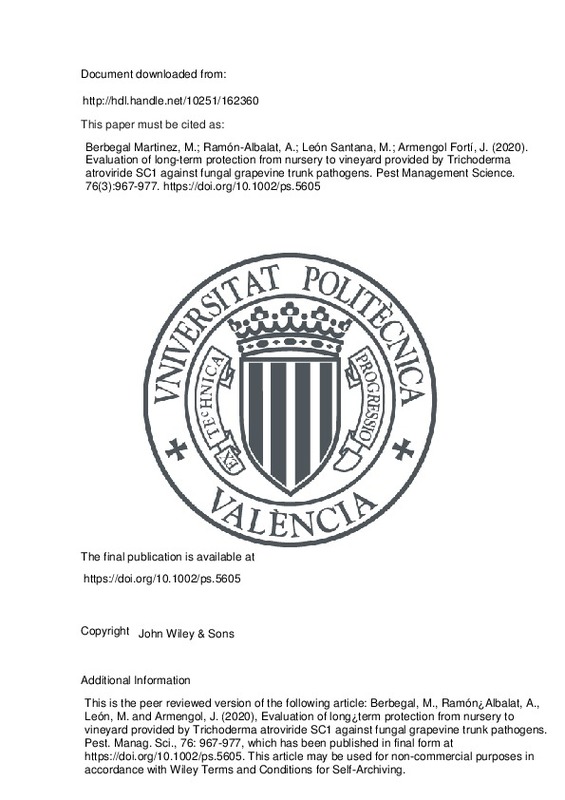Gramaje, D., Úrbez-Torres, J. R., & Sosnowski, M. R. (2018). Managing Grapevine Trunk Diseases With Respect to Etiology and Epidemiology: Current Strategies and Future Prospects. Plant Disease, 102(1), 12-39. doi:10.1094/pdis-04-17-0512-fe
Mondello, V., Songy, A., Battiston, E., Pinto, C., Coppin, C., Trotel-Aziz, P., … Fontaine, F. (2018). Grapevine Trunk Diseases: A Review of Fifteen Years of Trials for Their Control with Chemicals and Biocontrol Agents. Plant Disease, 102(7), 1189-1217. doi:10.1094/pdis-08-17-1181-fe
Gramaje, D., & Armengol, J. (2011). Fungal Trunk Pathogens in the Grapevine Propagation Process: Potential Inoculum Sources, Detection, Identification, and Management Strategies. Plant Disease, 95(9), 1040-1055. doi:10.1094/pdis-01-11-0025
[+]
Gramaje, D., Úrbez-Torres, J. R., & Sosnowski, M. R. (2018). Managing Grapevine Trunk Diseases With Respect to Etiology and Epidemiology: Current Strategies and Future Prospects. Plant Disease, 102(1), 12-39. doi:10.1094/pdis-04-17-0512-fe
Mondello, V., Songy, A., Battiston, E., Pinto, C., Coppin, C., Trotel-Aziz, P., … Fontaine, F. (2018). Grapevine Trunk Diseases: A Review of Fifteen Years of Trials for Their Control with Chemicals and Biocontrol Agents. Plant Disease, 102(7), 1189-1217. doi:10.1094/pdis-08-17-1181-fe
Gramaje, D., & Armengol, J. (2011). Fungal Trunk Pathogens in the Grapevine Propagation Process: Potential Inoculum Sources, Detection, Identification, and Management Strategies. Plant Disease, 95(9), 1040-1055. doi:10.1094/pdis-01-11-0025
Kaplan, J., Travadon, R., Cooper, M., Hillis, V., Lubell, M., & Baumgartner, K. (2016). Identifying economic hurdles to early adoption of preventative practices: The case of trunk diseases in California winegrape vineyards. Wine Economics and Policy, 5(2), 127-141. doi:10.1016/j.wep.2016.11.001
Úrbez-Torres, J. R., & Gubler, W. D. (2010). Susceptibility of grapevine pruning wounds to infection by Lasiodiplodia theobromae and Neofusicoccum parvum. Plant Pathology, 60(2), 261-270. doi:10.1111/j.1365-3059.2010.02381.x
Eskalen, A., Feliciano, A. J., & Gubler, W. D. (2007). Susceptibility of Grapevine Pruning Wounds and Symptom Development in Response to Infection by Phaeoacremonium aleophilum and Phaeomoniella chlamydospora. Plant Disease, 91(9), 1100-1104. doi:10.1094/pdis-91-9-1100
Elena, G., & Luque, J. (2016). Seasonal Susceptibility of Grapevine Pruning Wounds and Cane Colonization in Catalonia, Spain Following Artificial Infection with Diplodia seriata and Phaeomoniella chlamydospora. Plant Disease, 100(8), 1651-1659. doi:10.1094/pdis-10-15-1186-re
Díaz, G. A., & Latorre, B. A. (2013). Efficacy of paste and liquid fungicide formulations to protect pruning wounds against pathogens associated with grapevine trunk diseases in Chile. Crop Protection, 46, 106-112. doi:10.1016/j.cropro.2013.01.001
Harman, G. E., & Kubicek, C. P. (Eds.). (1998). Trichoderma And Gliocladium, Volume 2. doi:10.1201/9781482267945
Harman, G. E. (2000). Myths and Dogmas of Biocontrol Changes in Perceptions Derived from Research on Trichoderma harzinum T-22. Plant Disease, 84(4), 377-393. doi:10.1094/pdis.2000.84.4.377
Mukherjee, M., Mukherjee, P. K., Horwitz, B. A., Zachow, C., Berg, G., & Zeilinger, S. (2012). Trichoderma–Plant–Pathogen Interactions: Advances in Genetics of Biological Control. Indian Journal of Microbiology, 52(4), 522-529. doi:10.1007/s12088-012-0308-5
Rajesh, R. W., Rahul, M. S., & Ambalal, N. S. (2016). Trichoderma: A significant fungus for agriculture and environment. African Journal of Agricultural Research, 11(22), 1952-1965. doi:10.5897/ajar2015.10584
Harman, G. E. (2006). Overview of Mechanisms and Uses of Trichoderma spp. Phytopathology®, 96(2), 190-194. doi:10.1094/phyto-96-0190
Pieterse, C. M. J., Zamioudis, C., Berendsen, R. L., Weller, D. M., Van Wees, S. C. M., & Bakker, P. A. H. M. (2014). Induced Systemic Resistance by Beneficial Microbes. Annual Review of Phytopathology, 52(1), 347-375. doi:10.1146/annurev-phyto-082712-102340
Van Wees, S. C., Van der Ent, S., & Pieterse, C. M. (2008). Plant immune responses triggered by beneficial microbes. Current Opinion in Plant Biology, 11(4), 443-448. doi:10.1016/j.pbi.2008.05.005
Berlanas, C., Andrés-Sodupe, M., López-Manzanares, B., Maldonado-González, M. M., & Gramaje, D. (2018). Effect of white mustard cover crop residue, soil chemical fumigation and Trichoderma
spp. root treatment on black-foot disease control in grapevine. Pest Management Science, 74(12), 2864-2873. doi:10.1002/ps.5078
Fourie, P. H., & Halleen, F. (2006). Chemical and biological protection of grapevine propagation material from trunk disease pathogens. European Journal of Plant Pathology, 116(4), 255-265. doi:10.1007/s10658-006-9057-9
Dissanayake, A. (2016). Botryosphaeriaceae: Current status of genera and species. Mycosphere, 7(7), 1001-1073. doi:10.5943/mycosphere/si/1b/13
Mostert, L., Groenewald, J. Z., Summerbell, R. C., Gams, W., & Crous, P. W. (2006). Taxonomy and Pathology of Togninia (Diaporthales) and its Phaeoacremonium Anamorphs. Studies in Mycology, 54, 1-113. doi:10.3114/sim.54.1.1
GARDES, M., & BRUNS, T. D. (1993). ITS primers with enhanced specificity for basidiomycetes - application to the identification of mycorrhizae and rusts. Molecular Ecology, 2(2), 113-118. doi:10.1111/j.1365-294x.1993.tb00005.x
Travadon, R., Lawrence, D. P., Rooney-Latham, S., Gubler, W. D., Wilcox, W. F., Rolshausen, P. E., & Baumgartner, K. (2015). Cadophora species associated with wood-decay of grapevine in North America. Fungal Biology, 119(1), 53-66. doi:10.1016/j.funbio.2014.11.002
O’Donnell, K., & Cigelnik, E. (1997). Two Divergent Intragenomic rDNA ITS2 Types within a Monophyletic Lineage of the FungusFusariumAre Nonorthologous. Molecular Phylogenetics and Evolution, 7(1), 103-116. doi:10.1006/mpev.1996.0376
Jacobs, K., Bergdahl, D. R., Wingfield, M. J., Halik, S., Seifert, K. A., Bright, D. E., & Wingfield, B. D. (2004). Leptographium wingfieldii introduced into North America and found associated with exotic Tomicus piniperda and native bark beetles. Mycological Research, 108(4), 411-418. doi:10.1017/s0953756204009748
Savazzini, F., Longa, C. M. O., Pertot, I., & Gessler, C. (2008). Real-time PCR for detection and quantification of the biocontrol agent Trichoderma atroviride strain SC1 in soil. Journal of Microbiological Methods, 73(2), 185-194. doi:10.1016/j.mimet.2008.02.004
Longa, C. M. O., Pertot, I., & Tosi, S. (2008). Ecophysiological requirements and survival of aTrichoderma atrovirideisolate with biocontrol potential. Journal of Basic Microbiology, 48(4), 269-277. doi:10.1002/jobm.200700396
Úrbez-Torres, J. R., Haag, P., Bowen, P., Lowery, T., & O’Gorman, D. T. (2015). Development of a DNA Macroarray for the Detection and Identification of Fungal Pathogens Causing Decline of Young Grapevines. Phytopathology®, 105(10), 1373-1388. doi:10.1094/phyto-03-15-0069-r
[-]







![[Cerrado]](/themes/UPV/images/candado.png)


